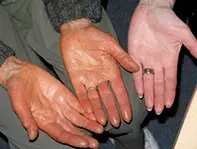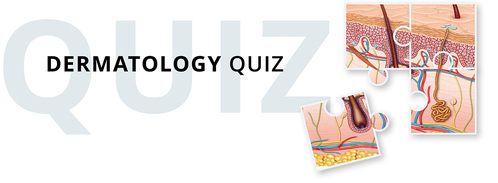What’s the diagnosis?
A woman with orange-coloured palms

Case presentation
A 62-year-old woman presents to her GP to discuss her osteoarthritis treatment. She is accompanied by her daughter, who mentions that she has noticed her mother’s palms to be a strange orange colour (Figure).
The patient is otherwise well. The rest of her skin and her sclerae are normal in appearance. Her current longstanding medications include meloxicam and paracetamol for her arthritis.
Diagnosis
Carotenaemia is the correct diagnosis. This is a harmless phenomenon that is seen in patients who are food faddists or who are taking dietary supplements that contain β-carotene or other carotenoids such as canthaxanthin. It is a spot diagnosis.
When asked about her diet, the patient explains that during the last year she has been consulting a naturopath about her arthritis. She now takes a number of supplements and eats large quantities of fruit and vegetables. She says that she uses carrots to make fresh vegetable juice every day.
Causes
Carotenaemia is usually caused by excessive intake of carotenoids, such as β-carotene, which are converted to vitamin A (retinol) in the body and contribute to normal skin colour. Carotenoids are found in the normal diet, the source being orange-coloured fruit and vegetables. When consumed to excess (most often in patients who drink large quantities of carrot juice), carotenoid levels in the blood are increased and the pigment is deposited in the skin and excreted in sweat. The deposition is most conspicuous where the stratum corneum is thickest: the palms and soles.
There is a rare inborn metabolic disorder in which the metabolic conversion of carotenoids to vitamin A is impaired, producing carotenaemia. In this situation, the onset is in infancy. The metabolic conversion may also be blocked in patients with hepatic disease.
Management
Striking orange discolouration confined to the palms and soles in an individual who is otherwise well is unusual. Yellow or orange discolouration of the skin can be seen in serious medical conditions and can be confused with carotenaemia. The discolouration in such conditions is usually more generalised. In the case of jaundice (hyperbilirubinaemia), the discolouration involves the sclerae.
The following conditions should be considered in any patient with yellow or orange skin discolouration:
• hyperlipidaemia
• diabetes
• renal disease
• hypothyroidism
• hepatic disease.
For this patient, it was therefore considered necessary to perform routine biochemistry tests (fasting lipids, blood sugar, thyroid stimulating hormone [TSH], liver function tests). The results were normal, and reassurance regarding the cause of her skin discolouration was all that was required. She was advised that reducing her intake of carrot juice and of dietary supplements that contain carotenoids would result in the colour of her palms gradually returning to normal.

